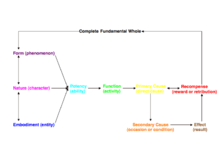Ten suchnesses

| Part of a series on |
| Mahāyāna Buddhism |
|---|
 |
|
Teachings |
|
Mahāyāna schools |
| Mahayana Buddhism portal |
The Ten suchnesses (Chinese: 十如是 shí rúshì; Japanese: 十如是 jū nyoze) are a Mahayana doctrine which is important, as well as unique, to that of the Tiantai (Tendai) and Nichiren Buddhist schools of thought. The doctrine is derived from a passage found within the second chapter of the Chinese translation of the Lotus Sutra, and is also known as the ten reality aspects, ten factors of life, or the Reality of all Existence.[1][2][3]
Overview
The ten suchnesses, or categories, are what led the sixth century Chinese Buddhist philosopher Zhiyi to establish the doctrine of the "three thousand [worlds] in one thought."[3] Nichiren regarded the doctrine of "three thousand [worlds] in one thought" (ichinen-sanzen) as the very essence of the Buddha's teachings.[4] He wrote in his work Kaimoku-shō (Essay on the Eye-opener) concerning ichinen-sanzen:
- The very doctrine of the Three Thousand Realms in One Mind of the Tendai sect appears to be the way to lead man to buddhahood.[4]
The principle of the Reality of All Existence not only analyzes what modern science would analyze in physical substances to the extent of subatomic particles, but also extends to mental state.[5] Accordingly, everyone's mind has existing within it the ten realms of existence which are said to be found within one another.[6] The suchnesses reveal the deepest reality inherent within all things, and, consequently, innumerable embodied substances existing in the universe are interrelated with all things.
The doctrine consists of ten words that are preceded by the words "such a" or "such an":[7]
- Such a Form (phenomenon)
- Such a Nature (character)
- Such an Embodiment (entity)
- Such a Potency (ability)
- Such a Function (activity)
- Such a Primary Cause (direct cause)
- Such a Secondary Cause (occasion or condition)
- Such an Effect (result)
- Such a Recompense (reward or retribution)
- Such a Complete Fundamental Whole
The suchnesses, one through nine, operate according to the law of the universal truth, namely from the "complete fundamental whole" under which no one, no thing, and no function can depart. All things, including man, along with their relations with everything else are formed from the Reality of All Existence that is the Ten Suchnesses.[8]
Definitions
The following definitions are given by Soka Gakkai English Buddhist Dictionary Committee (2002) and describe what each suchness means in more detail:
- Appearance (Form): the attributes of everything that is discernible, such as color, shape, or behavior.
- Nature (Nature): the inherent disposition or quality of a person or thing that cannot be discerned from the outward appearance.
- Entity (Embodiment): the substance of life that permeates as well as integrates both appearance and nature.
The above three suchnesses describe the reality of life itself. The next six suchnesses, from the fourth through the ninth, explain the functions and workings of life.
- Power (Potency): life's potential energy.
- Influence (Function): the activity produced when life's inherent power or potential energy is activated.
- Internal cause (Primary Cause): the potential cause in life that produces an effect of the same quality as itself, i.e., good, evil, or neutral.
- Relation (Secondary Cause): the relationship of secondary, indirect causes to the internal cause. Secondary causes are various conditions, both internal and external, that help the internal cause produce an effect.
- Latent effect (Effect): the dormant effect produced in life when an internal cause is activated through its related conditions.
- Manifest effect (Recompense): the tangible, perceivable effect that emerges in time as an expression of a dormant effect and therefore of a potential cause, again through its related conditions.
- Consistency from beginning to end (Complete Fundamental Whole): the unifying factor among the ten suchnesses. It indicates that all of the other nine suchnesses from Appearance to Manifest Effect are consistently interrelated. All nine suchnesses thus harmoniously express the same condition of existence at any given moment.
See also
- Reality in Buddhism
- Tathata
Notes
- ↑ Reeves 2008, p. 425
- ↑ Soka Gakkai English Buddhist Dictionary Committee 2002
- ↑ 3.0 3.1 Kato 1993, p. 52
- ↑ 4.0 4.1 Niwano 1976, p. 109
- ↑ Niwano 1976, p. 111
- ↑ Niwano 1976, p. 110
- ↑ Niwano 1976, pp. 110–111
- ↑ Niwano 1976, p. 112
References
- Katō, Bunnō; Tamura, Yoshirō; Miyasaka, Kōjirō (1993). The Threefold Lotus Sutra: The Sutra of Innumerable Meanings, The Sutra of the Lotus Flower of the Wonderful Law, The Sutra of Meditation on the Bodhisattva Universal Virtue (PDF). Tōkyō: Kōsei Publishing Company. ISBN 4-333-00208-7.
- Niwano, Nikkyo (1976), Buddhism For Today: A Modern Interpretation of the Threefold Lotus Sutra (PDF), Tōkyō: Kōsei Publishing Co., ISBN 4-333-00270-2
- Reeves, Gene (2008). The Lotus Sutra: A Contemporary Translation of a Buddhist Classic. Somerville: Wisdom Publications. ISBN 0-86171-571-3.
- Soka Gakkai English Buddhist Dictionary Committee (2002). The Soka Gakkai Dictionary of Buddhism. Tōkyō: Soka Gakkai. ISBN 978-4-412-01205-9.
- Robert, Jean-Noel (2011). "On a Possible Origin of the « Ten Suchnesses » List in Kumārajīva’s Translation of the Lotus Sutra". Journal of the International College for Postgraduate Buddhist Studies 15: 54 -72.
External links
| ||||||||||||||||||||||||||
